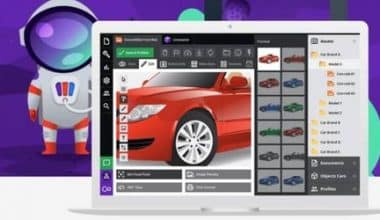Businesses must learn to manage their metadata to ensure accuracy and avoid errors. Everyone knows we depend on making the right decisions as well as boosting productivity. That’s why most businesses use metadata management tools to ensure that they handle their data repository. There are several tools for enterprise metadata management, and if you think it costs a fortune, you can check out the various open-source metadata management tools. If you’re unsure about which metadata management tools to use in managing your data, just go through our list below.
What Is Metadata?
Metadata is simply information about data. That’s a bit complicated, right? I know. However, that’s really all that metadata is all about: providing information about other data. A better definition is that metadata is deliberate, structured data that gives details about other data.
Metadata assists users in finding the data they require by viewing an inventory of available data and assessing the data’s suitability for intended uses. Metadata is defined as “information that describes various aspects of an organization’s information asset in order to improve its usability across its life cycle.”
What Are The Types Of Metadata?
Generally, we place metadata in categories. These categories are also seen as types of metadata. The following are the types of metadata;
- Active metadata
- Descriptive information
- Structural information
- Administrative information
- Reference information
How Do You Manage Metadata?
- First, discover your core attributes and data sources.
- Discover your key data experts.
- Finally, create a protocol and be consistent.
What Are Metadata Management Tools?
Metadata management tools are typically flexible, all-purpose applications or software programs with specific features that facilitate efficient metadata management. Now, these tools are essential for effective data searching, retrieval, and comprehension. The general features include a business glossary, impact analysis, and data profiling. It also extends to support workflow, data lineage, unifying data with multiple connectors, and so on.
We can also view metadata management tools as a system that provides a shared language for data citizens from different backgrounds to collaborate and get things done. Metadata management tools are simply multifunctional tools that add useful information to the data stored by the enterprise environment. If the information within a business will be searchable, accurate, easy to find, and understandable, then there’s a need to integrate metadata management tools.
Enterprise Metadata Management Tools
According to Gartner, enterprise metadata management (EMM) is the business discipline for managing the metadata of an organization’s information assets.
Every enterprise has data across its operations and must therefore integrate metadata management tools to effectively manage its data across different sources and units. The need for metadata management keeps increasing on a daily basis. Luckily, we also record an increase in the tools available to make it possible. Some of these include the following;
#1. Informatica Metadata Management
First in our list of enterprise metadata management tools is Informatic. Informatica’s metadata management tool is built with active metadata to assist enterprises in fully leveraging the value of all their data.
The Informatics management tool generally scans all of the enterprise’s data systems for metadata, including databases and filesystems, integration tools and processes, and analytics and data science tools.
With Informatics, businesses can access their technical database schemas, mappings, and code, as well as business, operational, and infrastructure databases and filesystems, integration tools and processes, and analytics and data science tools usage. Using artificial intelligence and machine learning, Informatica builds a knowledge graph of an organization’s data assets and their connections.
Key Features Of Informatics
- Data Classification
- Data Lineage
- Change History
- Business Glossary
- Rate assets
- Data Profiling
#2. Octopai
Octopai made it to our list of enterprise metadata management tools. It’s a unified, cross-platform automation solution for metadata management that helps data and analytics groups find and manage their common data.
It stores and manages metadata in a central repository, and you’ll quickly get results with a smart engine. The smart engine with hundreds of crawlers searches all metadata quickly and shows the results. It stores metadata in a central repository, and a smart engine with hundreds of crawlers searches all metadata quickly and shows the results. business intelligence, Octopai may be your best bet.
In summary, Octopai streamlines metadata management and analysis to help business intelligence teams within enterprises find and understand their data with greater speed and precision, thereby enhancing business operations, data quality, and data governance.
#3. Alation Data Catalog
The Alation data catalog with its unified interface, makes finding, analyzing, and controlling all enterprise data easy. In indexing, it uses Al intelligent and that ensures that data searches are easily discoverable.
Knowledge is captured in discussions and wiki-style articles, which direct newcomers to the best person to answer their questions.
The smart SQL editor makes it possible for users to formulate queries in a more natural way, bringing to the fore suggestions, compliance flags, and applicable policies
#4. IBM
You can’t possibly make a list of enterprise metadata management tools without mentioning IBM. When it comes to enterprise data and AI model governance, quality, and collaboration, IBM’s Watson Knowledge Catalog you should check out.
Among its many useful features is an AI-generated business glossary culled from the most common regulatory terms and automatic data discovery and metadata generation.
IBM’s InfoSphere Information Server includes a metadata repository for storing and sharing metadata among the suite’s tools and other, external tools and databases.
Metadata can be brought in from many different places, exported in a number of ways, and moved freely between the design, test, and production repositories.
Key Features of IBM Enterprise Metadata Management Tools
The following are the key features of IBM enterprise metadata management tools;
- Data Profiling
- Rating of Data
- Data Lineage
- Reference Data
- Change History
- Data Classification
- Support for workflow
#5. Dataedo
With Dataedo, every enterprise can quickly and easily, catalog their data in a central metadata repository. It goes as far as defining each data asset, retrieving and filing table relationships, creating a business glossary, and mapping it to a data dictionary. It equally labels sensitive data, envisions data models with ER Diagrams, and shares information with the data community in a participatory web portal or HTML exports.
Key Features Of Dataedo Enterprise Management Tools
The following are the unique features of Dataedo enterprise management tools;
- Business Glossary
- Change History
- Data Classification
- Reference data
- On-premises cloud
#6. Infogix
Infogix Data3Sixty is also on our list of metadata management tools because of Infogox Data360 Govern. If you want the best in quality, value, and reliable data at all times, trust Infogix Data360 to do the job. Users can easily score, profile, crawl, and manage your intricate metadata. The result is usually a repository of all your data assets that you can easily browse through at any day and time.
Key Features of Infogix Data3Sixty
The key features of Infogix Data3Sixty include the following;
- Data classification
- Profiling
- Rating assets
- Data lineage
- Support for workful
#7. Io-Tahoe
If you want a next-generation metadata management tool, you really should check out Io-Tahoe. Io-Tahoe helps businesses move quickly toward modern data management practices and significantly enhances data governance and regulatory compliance with its Artificial intelligence.
Key Features of Io-Tahoe Enterprise Metadata Management Tools
The following are the key features of Io-Tahoe;
- Data Classifications
- Change History
- Business Glossary
- Data Profiling
- Data Lineage
- Rating of assets
- Support of workflow
#8. Global IDs
No matter where they may be in the ecosystem, the Global IDs platform always has an accurate and complete inventory of all relevant data assets. It uses machine learning to close the gap between physical and logical metadata. I particularly love the fact that, irrespective of your business price, Global IDs can automate your metadata because it’s extensible.
#9.TIBCO Data Virtualization
TIBCO Data Virtualization is one of the metadata management tools that allows its users to create and manage virtualized databases and IT-curated data services with unprecedented speed and efficiency. It hides the complexity of multiple technologies, protocols, formats, and locations, creating one friendly user interface through which they can access their data.
What’s your business’s need? Ease of accessibility, a friendly user interface, and a secure or flexible environment? TIBCO Data Virtualization is able to meet your demands.
#10. Select Star
If you’re in search of metadata management tools for your database management and data governance, you really should check out Select Star. Select Star has a user-friendly interface, which has a quick time-to-value and reduces the time and resources usually used for data serving.
#11. Solidatus
Solidatus users typically get more business value out of their data compared to some other tools. They have a database management technology that connects and visualizes data across any enterprise. It gives users the resources they need to rethink a solid data foundation that includes effective metadata management, data quality, cataloging, and data governance.
It gives users the resources they need to rethink a solid data foundation that includes effective metadata management, data quality, cataloging, and data governance.
#12. Zeenea Data Catalog
Zeenea is a data catalog cloud-based platform that provides a trustworthy and clear database, helping businesses advance their data ideas. Its user interface will provide each user with the exact thing they request. From discovering, and governing, to managing the information in your company, a few clicks are all you need.
I do love the fact that Zeenea offers its users two interfaces. The first is Zeenea Studio, which is for data management teams, and the second is Zeenea Explorer, which streamlines the search and browsing process for catalog users.
In order to create an enterprise-wide information repository, this platform provides universal connectivity, and an API-first strategy to adapt to all systems, and all data strategies.
Which is a helpful tool for metadata implementation?
Using TopBraid EDG-Metadata Management (TopBraid EDG-MM), businesses may control the information that is disclosed about their data assets, software applications, infrastructure, operational capabilities, and business procedures. Understanding the ancestry of the data and its metadata, as well as how to manage enterprise data as assets, are crucial.
What is metadata in SQL?
Data “about the data” is what is known as metadata. Metadata is anything that refers to the database as a whole rather than just its contents. The majority of the text returns from SHOW, as well as column names, database names, user names, and version names, are metadata.
What is metadata in DB?
Data about data is referred to as metadata. The term “metadata” refers to data that provides information on one or more characteristics of the data; it is used to condense essential details about data that can facilitate tracking and working with particular data. Here are a few instances: methods for data production.
Where is metadata stored?
Numerous locations can be used to store metadata. When the metadata refers to databases, the data is frequently kept in the database’s tables and columns. The metadata may occasionally be found in a specialized database or document called a data dictionary or metadata repository that was created specifically to house such data.
Is SQL DB metadata?
As most of you probably already know, metadata gives the most important and pertinent information about the data. SQL Server’s metadata functions provide information on the database, database objects, database files, file groups, and other SQL Server components.
What is the difference between data and metadata?
How do data and metadata differ from one another? Data can simply be a piece of information, a list of measurements or observations, a narrative, or a description of a specific thing, but metadata includes details about the original data that help identify its nature and characteristics.
What is metadata in Excel?
Document properties, commonly referred to as metadata, are specifics that describe or identify a file. They provide information about the document’s topic or contents, such as the title, author, subject, and keywords.
Open-Source Metadata Management Tools
Open-source metadata management tools are generally high-quality software that’s free or can be gotten at a lower price than their proprietary alternatives. They are also highly scalable, flexible, and limitless in their application (ideal for high data volumes).
#1. Amundsen Lyft
One of the most common open-source metadata management tools is Amundsen. Like Facebook, it wasn’t made public immediately. It was built in 2018 by the Lyft engineering team. Amundsen became available to the public as an open-source management tool in 2019.
There is a strong sense of community amongst Amundsen’s contributors and users. Many organizations have taken advantage of this open-source data catalog tool and built upon it to advance data democratization, governance, and metadata service efforts.
Key Features of Amundsen Open Source Metadate Management Tools
The following are the key features of Amundsen Open source Metadata management tools;
Metadata generation and curation systems
With Amundsen’s open-source data management tool, users are presented with a manually curated description upon clicking on any data asset. Amundsen generates these descriptions automatically.
Uncover Reliable Data
With a single search, Amundsen facilitates data discovery from multiple sources. Metadata is displayed directly within the search results.
Easily Relate Context With Coworkers
With Amundsen, context or data can be easily assessed by co-workers with ease. Also, a single update or modification is spread across the entire system.
Gaining insight through data analysis
Amundsen keeps track of your data. From the most frequently used data to searches and queries, all this information can be used to make adjustments or modify data for better use.
#2. Netflix Metacat
Metacat is an open-source metadata management tool with unique features compared to other tools. The metadata management tool is unique because of how easy it is to discover, process, manage, and classify data. Metacat was developed at Netflix and released as open source in the year 2018. If you are in search of free open-source metadata management tools, check out Netflix Metacat.
Key Features Netflix Metacat
The following are the key features of Netflix Metacat open source metadata management tool
Abstraction of Data And Compatibility
Datasets are accessible across Netflix’s various query engines thanks to Metacat, which acts as a common abstraction layer.
Keeping Track Of Business And User-Defined Metadata
It isn’t just enough to integrate a metadata management tool. You’ll have to highlight the rules for its use. Well, not to worry. The Netflix management tool, Metacat, helps enterprises document business and user-defined metadata about data assets. That way, users can easily access these at their own convenience.
Auditing And Notification Of Data Changes
Most people do enable notifications on their phones, and any new update pops up with a notification button. Metacat also has a feature that records changes and new updates.
#3. LinkedIn DataHub
Another open-source metadata tool that is at the top of our management tools list is LinkedIn DataHub. It was developed in 2019 and became an open-source data management tool in 2020. As an open source management tool, its main focus is to address data cataloging, discovery, observability, and lineage issues.
Key Features of LinkedIn DataHub Open Source Metadata Management Tools
The following are the key features of LinkedIn DataHub Open source metadata management tools;
Automates The Ingestion of Metadata
All you need to ingest your metadata into LinkedIn DataHub from various sources are APIs or Kafka streams.
Simple Data Discovery
The use of metadata management tools is of no use when there are search difficulties. Therefore, there’s a need for businesses to ensure that whatever tool they choose to integrate into their systems is user-friendly. LinkedIn DataHub allows three types of interactions: search, browsing, and viewing/editing metadata. That way, data can be easily discovered.
Develop Context Around Data
The LinkedIn DataHub has a profile page that usually displays the entire metadata that’s in line with that particular data. This ensures that at every point, a user can always get what they want or search for within a context
#4. Apache Atlas
If you’re in search of an open-source metadata management tool and governance platform, check out Apache Atlas. Apache uses metadata to solve data cataloging, classification, discovery, governance, and collaboration challenges. As a result, it’s widely recognized as one of the building blocks of the modern data platform.
List Of Metadata Management Tools
Check out Business Yield’s list of metadata management tools;
- Smartlogic
- SAP
- Alex solution
- OvalEdge
- Manta
- Asa Technologies
- Erwin
- Adaptive metadata manager
- Collibra
- Oracle
What Tool Can You Use To View Metadata?
ExifTool. ExifTool is a command-line program and a platform-independent Perl library for reading, writing, and editing metadata in a variety of files. It displays the Exif and IPTC data in local and remote JPEG images. You can also check out Jalbum, Gimp, PhotoshopDC
Which Tool Is Used For Data Management?
- Hitachi
- Commvault
- Cloudera
- Druva
Which Service Should You Use To Manage Data?
Data catalog. This is because it can be used to harvest technical metadata from a large number of supported data sources accessible via public or private IP addresses.
How Do You Implement Metadata Management?
- Assign an Administration Team for Metadata
- Annotate your metadata strategy.
- Embrace Metadata Standards
- Implement a Metadata Management Tool
- Extend the Metadata Management Strategy Organization-Wide.
Conclusion
It isn’t enough to create or store your business metadata, it must be managed to ensure ease of accessibility.
Metadata Management Tools FAQs
Where is metadata stored?
We store metadata in two places. The first is a digital file and the second is a database.
Why is metadata so important?
Metadata is crucial because it helps businesses organize their data in a meaningful way that makes it easier to access the information they need.
- MONEY MANAGEMENT TOOLs: What It Is, How To Use It, And Free Online Tools
- SALES LEADS: How to Generate Sales Lead for any Business, Explained!!!






